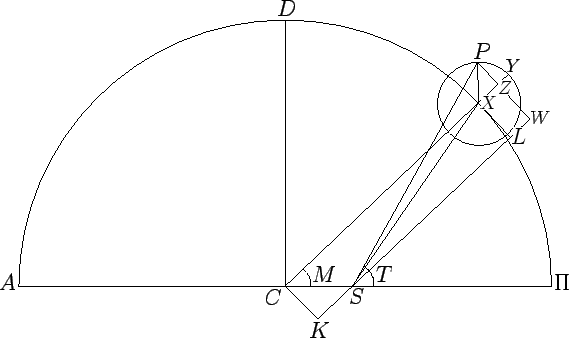


Next: The Sun
Up: Geometric Planetary Orbit Models
Previous: Model of Ptolemy
Copernicus' geometric model of a heliocentric planetary orbit is illustrated in Fig. 20.
The planet  rotates on a circular epicycle
rotates on a circular epicycle  whose center
whose center  moves around the sun on the eccentric circle
moves around the sun on the eccentric circle  (only
half of which is shown). The diameter
(only
half of which is shown). The diameter  is the effective major axis of the orbit, where
is the effective major axis of the orbit, where  is the geometric center of circle
is the geometric center of circle  , and
, and  the fixed position of the sun. When
the fixed position of the sun. When  is at
is at  or
or  the planet is at its perihelion
or aphelion points, respectively. The radius
the planet is at its perihelion
or aphelion points, respectively. The radius  of circle
of circle  is the effective major radius,
is the effective major radius,  , of the orbit. The distance
, of the orbit. The distance  is
equal to
is
equal to  , where
, where  is the orbit's effective eccentricity. Moreover, the radius
is the orbit's effective eccentricity. Moreover, the radius  of the epicycle is equal to
of the epicycle is equal to  .
The angle
.
The angle  is identified with the mean anomaly,
is identified with the mean anomaly,  , and increases linearly in time. In other words, as seen from
, and increases linearly in time. In other words, as seen from  , the center of
the epicycle
, the center of
the epicycle
 moves uniformly around circle
moves uniformly around circle  in a counterclockwise direction. The angle
in a counterclockwise direction. The angle  , where
, where  is
point at which
is
point at which  produced meets the epicycle, is equal to
the mean anomaly
produced meets the epicycle, is equal to
the mean anomaly  . In other words, the planet
. In other words, the planet  moves uniformly around the epicycle
moves uniformly around the epicycle  , in an counterclockwise direction, at twice
the speed that point
, in an counterclockwise direction, at twice
the speed that point  moves around circle
moves around circle  .
Finally,
.
Finally,  is the radial
distance,
is the radial
distance,  , of the planet from the sun, and angle
, of the planet from the sun, and angle  is the planet's true anomaly,
is the planet's true anomaly,  .
.
Figure 20:
A Copernican orbit.
 |
Let us draw the straight-line  parallel to
parallel to  , and passing through point
, and passing through point  , and then complete the rectangle
, and then complete the rectangle  . Simple geometry reveals that
. Simple geometry reveals that
 ,
,
 , and
, and
 . Let
. Let  be drawn normal
to
be drawn normal
to  , and let it meet
, and let it meet  produced at point
produced at point  . Simple geometry reveals that
. Simple geometry reveals that  ,
,
 , and
, and
 . It follows that
. It follows that
 , and
, and
 .
Moreover,
.
Moreover,
 ,
which implies that
,
which implies that
 |
(91) |
Now,  , where
, where  is angle
is angle  . However,
. However,
 |
(92) |
Finally, expanding the previous two equations to second-order in the small parameter  , we obtain
, we obtain
It can be seen, by comparison with Eqs. (81)-(82) and (89)-(90), that, as is the case for Ptolemy's model, both the
relative radial distance,  , and the true anomaly,
, and the true anomaly,  , in Copernicus' geometric model of a heliocentric planetary orbit only deviate from those in the (correct) Keplerian model to second-order in
, in Copernicus' geometric model of a heliocentric planetary orbit only deviate from those in the (correct) Keplerian model to second-order in  . However, the deviation in the Ptolemaic
model is slightly smaller than that in the Copernican model. To be more exact, the maximum deviation in
. However, the deviation in the Ptolemaic
model is slightly smaller than that in the Copernican model. To be more exact, the maximum deviation in  is
is  in the former model, and
in the former model, and  in the latter. On the other hand, the maximum deviation in
in the latter. On the other hand, the maximum deviation in  is
is  in both models.
in both models.



Next: The Sun
Up: Geometric Planetary Orbit Models
Previous: Model of Ptolemy
Richard Fitzpatrick
2010-07-21

![]() parallel to
parallel to ![]() , and passing through point
, and passing through point ![]() , and then complete the rectangle
, and then complete the rectangle ![]() . Simple geometry reveals that
. Simple geometry reveals that
![]() ,
,
![]() , and
, and
![]() . Let
. Let ![]() be drawn normal
to
be drawn normal
to ![]() , and let it meet
, and let it meet ![]() produced at point
produced at point ![]() . Simple geometry reveals that
. Simple geometry reveals that ![]() ,
,
![]() , and
, and
![]() . It follows that
. It follows that
![]() , and
, and
![]() .
Moreover,
.
Moreover,
![]() ,
which implies that
,
which implies that
![]() , we obtain
, we obtain